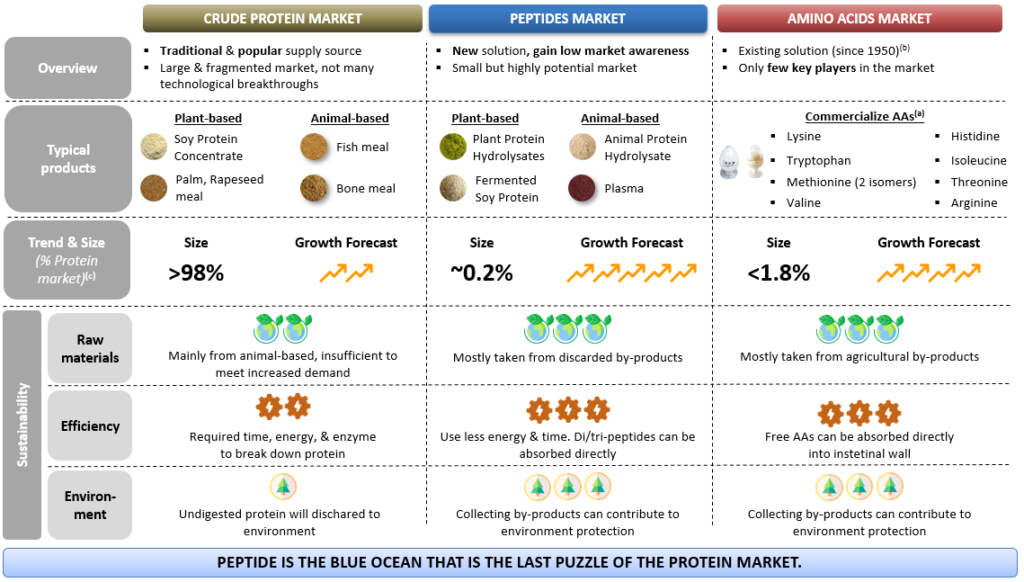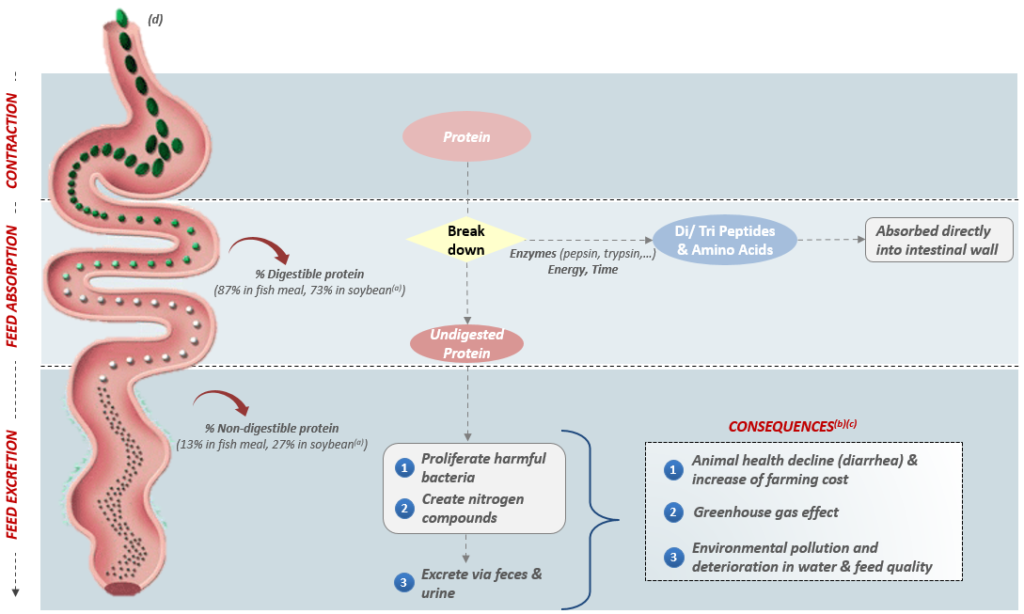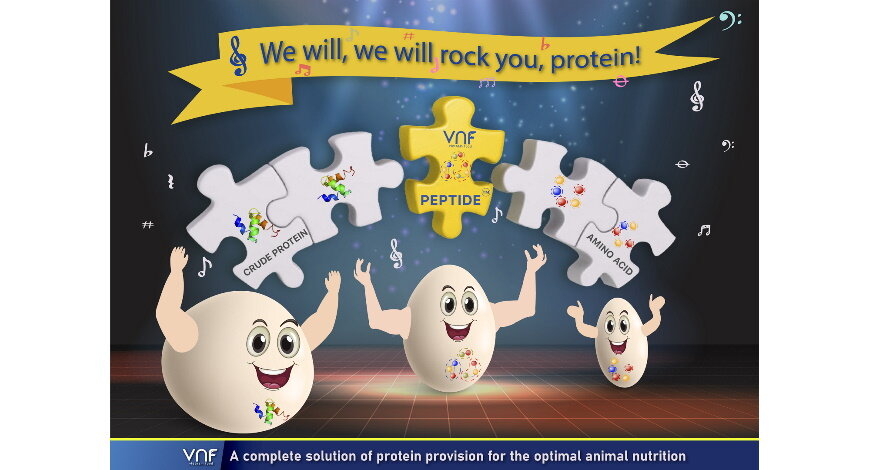Follow our “Shrimp-based Functional Peptides” Series here:
| Part 1: Peptides – The missing piece of the protein puzzle |
| Part 2: Superior digestibility of Shrimp-based Functional Peptides |
| Part 3: Shrimp-based Functional Peptides as novel & effective palatants |
| Part 4: Bioactivity of Shrimp-based Functional Peptides |
| Part 5: VNF’s holistic solutions for the protein market |
Protein is the crucial growth factor in animal nutrition. Protein supplied to animals comes in three main forms: Crude protein, Amino Acids, and Peptides.
- Crude protein: Although crude protein is the traditional and common protein supply source, it is now facing sustainability and efficiency problems. Animal-based protein is depleting and becoming more costly. On the other hand, plant-based protein contains anti-nutritional factors and lacks palatability features.
- Free Amino Acids: Introduced to the feed industry in the 1950s, Free Amino Acids are positioned to complement crude protein by supplementing the insufficient amino acids [1]. However, high technology barriers mean that only a few big companies can commercially synthesize Amino acids, with their focus primarily on Essential Amino Acids (EAA).
- Peptides: Peptides are a short chain consisting of 2-71 Amino Acids [2]. Peptides offer a rich multitude of benefits, including providing nutrition, boosting palatability, gut health functions, and enhancing immunity, etc. With an abundance of advantages, peptides are gaining increasing interest with high growth potential.
Figure 1. Crude protein, Peptide, and Amino Acids (AAs) markets overview

This article represents the first of VNF’s Shrimp-based Functional Peptides series, where we introduce the functions, mechanisms, and competitive advantages of peptides as the much-needed last piece of the global protein market. Let’s first be on the same page with an understanding of protein’s journey in the body!
PROTEIN CATABOLISM AND ANABOLISM
Figure 2: Protein catabolism and anabolism

Upon entering the stomach, Protein is broken down by digestive enzymes into Peptides and free AAs [2], in which only Di/Tri-Peptides and AAs can be directly absorbed through intestinal wall [3] to be used to build new proteins for the body. Longer chain peptides and undigested protein that are not digested [4] once reaching the colon will create a favorable environment for pathogenic bacteria to proliferate. Resulting consequences include detrimental harm to the animal’s health, environment, and subsequently, farmers’ profit (see figure 3 for more details).
Considering crude protein digestion requires many resources (enzymes, energy expended, time), it is not optimal nutrition. Thus, a more efficient and sustainable solution is urgently needed.
Figure 3. Excess protein discharge and its consequences

Free Amino Acids provide complementary values to Crude protein, such as improving digestibility, mitigating health risks from excess protein, etc. Animals need more than 20 AAs to synthesize protein [5], yet only 8 AAs are commercialized to this day. Free Amino Acids are therefore not a stand-alone solution.
VNF’S SHRIMP-BASED FUNCTIONAL PEPTIDES
We are confident that VNF’s shrimp-based functional peptides will achieve optimal protein usage by animals. VNF’s peptides help diversify the AA profile and improve palatability, digestibility, and overall health performance. Besides, we have successfully built a sustainable and cost-effective supply solution thanks to our proprietary biotechnologies and zero-waste production mindset.
Figure 4: VNF’s shrimp-based functional peptides – complementary solution for the protein market

Stay tuned for the next article of the series, where we expand and discuss the complementary values of our shrimp-based Functional peptides to Crude protein and AAs!
Reference
- Pierre DALIBARD, Vincent HESS, Loïc LE TUTOUR, Manfred PEISKER, Silvia PERIS, Ainhoa PEROJO GUTIERREZ, Mark REDSHAW, Amino Acids in Animal Nutrition, Fefana Publication, 2014, ISBN 978-2-9601289-3-2
- G.K. Grimble, Mechanisms of Peptide and Amino Acid Transport and Their Regulation, Proteins, Peptides and Amino Acids in Enteral Nutrition: Nestlé Nutrition Workshop Series Clinical & Performance Program, Vol. 3, pp. 63–88, 2000
- Henry J. Binder and Adrian Reuben, Nutrient digestion and absorption, Medical Physiology A Cellular and Molecular Approach, Updated 2nd Ed
- J.P.F. D’Mello, Amino acids in animal nutrition, CABI Publishing, 2003, ISBN: 0-85199-654-X
- Michael J. Lopez; Shamim S. Mohiuddin, Biochemistry, Essential Amino Acids, StatPearls Publishing; 2021


